Bamboo!! Improving island economy and resilience with Guam College students
University of Guam, Geography Department, PO Box 5172, UOG Station, Mangilao 96923, Guam alowen2@gmail.com
Abstract
This study examines possibilities in improving Guam’s economic independence. Growing economically and culturally sustainable industries benefit future generations. In this work bamboo, historically utilized on the island by the native CHamoru, is evaluated for industry and market potential specifically for Guam. Young adults of the island engaged to find creative possibilities for improving economic sustainability, utilizing methods that worked for them. Results include the use of social networking, gaining viewpoints of young adults who are far more interested in marketing the products than manufacturing them. Additionally, a potential for bamboo as a food source and charcoal aligns with the fiesta culture of Guam. Sourcing of Bamboo vulgaris, Guamís major bamboo species, has ecological benefits, while blumeana could be cultivated for crafts for export and tourists. Future study is planned to further involve young adults utilizing social networking methods developing culturally appealing and ecologically beneficial industry for the island.
Keywords
Island, Economy, Ecology, Bamboo, Guam, Culture, Sustainable, Agriculture
Introduction
The island of Guam’s mid-Pacific location has fostered adaptability in the ecology and the people that live here. Typhoons, earthquakes, humidity, wind and rain – as well as influx of immigrants and waves of colonization have made Guam’s people versatile and resilient in the face of change.
Like many islands, Guam’s history of interaction with other cultures has affected its economy. Guam’s economy remains dependent upon government, military and tourism and could benefit by diversifying and improving adaptability and resiliency. Culture and ecology are considerations in developing economic sectors that will improve economic versatility and “bounce back” Guam’s economy during challenging events and times. In previous culture change studies (Owen, 2012, 2011, 2010) Guam’s young adult population was determined to have differing cultural views from the older age ranges – using more social technology, losing ancestral languages and religion and displaying a blurring of gender roles. Another attribute of this group is concern, and often apathy regarding their ability to address and change current economic conditions in the current volatile condition of the global economy.
The young adult sector inherits the island’s condition – its ecological and economic health. In this study, College students at the University of Guam are challenged to engage creatively in addressing their future and the future of the island. The study purpose is threefold: (1) examine the potential of a resource that fosters economic resiliency on the island, (2) involve Guam College students in finding creative ways of building ecologically and culturally friendly business for the island and (3) provide new ideas and information on sustainable resource building for application elsewhere.
There is a history of use of bamboo on Guam. Guam’s indigenous people, the CHamoru, used it to create fishing devices such as nets, poles, and weirs during pre-colonial times (Tolentino, 2015). Bamboo was selected for the investigation because there is a current supply, it has a history of use on the island yet isn’t currently utilized, and because it grows well in Guam.
The research question for this study is as follows: what is the potential of bamboo for improving economic resiliency in Guam?
Study objectives include:
- (1)
- Identify bamboo species, location and product uses in Guam
- (2)
- Analyze manufacture, industry location, licenses, labor and ecological considerations
- (3)
- Determine market feasibility and local perception
Methods
A Field study was designed and conducted with the participation of University of Guam students for an economic geography class project during the fall semester of 2014. Students provided input to the research design, collected and compiled field data for the study.
Current Bamboo locations were determined through an aerial photography analysis of Guam. Short interviews of business owners, farmers, agricultural experts, faculty members and government officials were conducted. The worldwide and Asian bamboo market and bamboo uses were researched and analyzed for feasibility in Guam. Questions for expert interviews were asked regarding bamboo life cycle, products and marketing. All participation in the study was voluntary and anonymous.
A perception study was developed using a short questionnaire to determine Guam young adult perception of a bamboo market. A questionnaire was designed by the using Google docs and delivered via social media and telephone. The survey targeted the young adult age group, to collect information on their perspectives on bamboo harvest, manufacture and marketing. Study participation consisted of 306 Guam residents over the age of 18. Results are reported with a 95 percent confidence level + or −5.6% accuracy for the population of 161,000 (United States Central Intelligence Agency, 2014). While it was understood that the young adult population was overrepresented – the survey was intended only to provide a general idea of interest level. Four multiple-choice questions regarding the perception of buying or marketing bamboo were asked, along with gender and age group were created online using Google Forms. Simple statistical summarization was used in data analysis.
Results and discussion
Guam’s available bamboo
The United States Territory of Guam’s mid-Pacific location is south of Japan, north of Australia, east of the Philippine islands and west of the United States. It is subtropical at approximately 14 degrees north latitude, and volcanic in origin. It is a “high island” created from two volcanoes worn down to create flat plateaus no higher than 2500 feet, ringed by limestone and surrounded by a thick protective ring reef. The single harbor, Apra Harbor, is the location of a United States naval base. Guam is divided into 19 villages (Fig. 1). All places referred to in this study will be indicated by village and may be located on the village map.
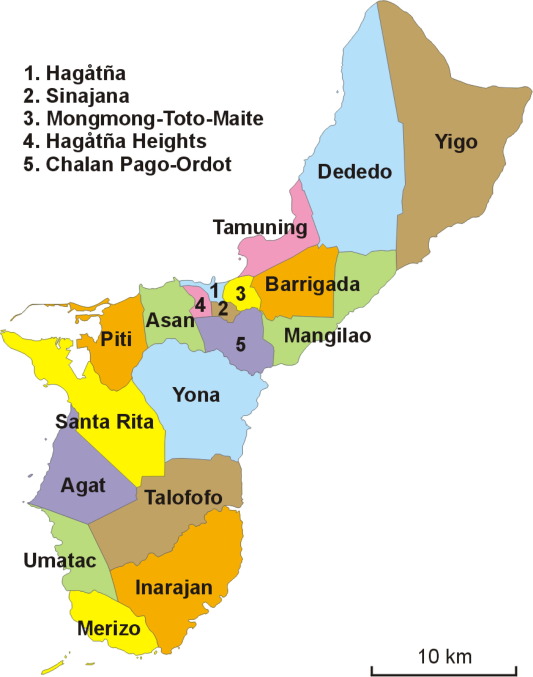
The most prevalent bamboo currently available in Guam is a non-cultivated variety growing in the waterways of the southern part of the island. Bambusa vulgaris is one of the most common bamboos of the world. Originating in Asia, it has become important for its wide range of uses as building material, for paper, tools and as a food source. In heavily populated areas, bamboo has been providing steady, plentiful and cheap housing materials. From Asia humanity spread it around the world. Now found in tropical and subtropical areas, it thrives along riverbanks, roadsides and open areas (McClure, 1966).
Bamboos are grasses, though they often appear like trees. The structure of bamboo differs from wood in that it has solid nodes and hollow stem or trunk and it is more difficult to chip. B. vulgaris is the largest of the bamboos, growing in large dense clumps up to 20 m (70 feet) tall and up to 10 cm (4 inches) thick.
On Guam, this plant is found especially in southern Guam, overcrowding the rivers and wetlands. (Figs. 2–4). Preferring a wide range of soils, it thrives and grows the fastest in wet soils. An exceedingly fast growing plant, in an ideal environment it can grow from 3 to 16 inches daily (Farrelly, 1984). For this reason it provides abundant material for any commercial venture that involves bamboo.
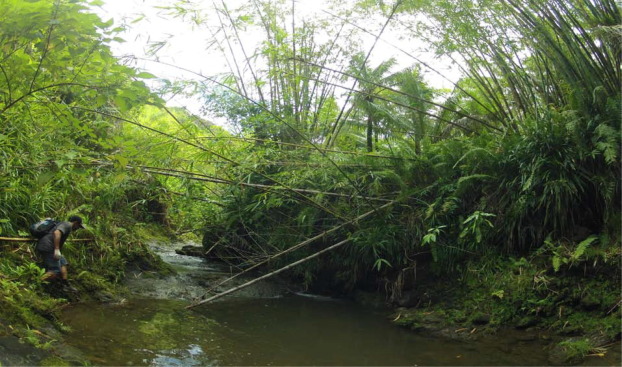
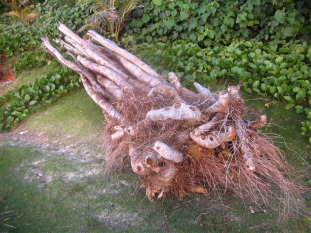
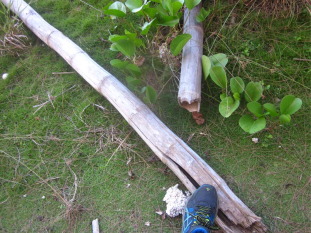
Bamboo is easily propagated by cutting “runners” from plant roots or by uprooting new stems and transplanting them (Raulerson and Rinehart, 1991) and also by other methods that are commonly used in farming such as air layering, seeds, tissue culture and division.
Bambusa blumeana, also known as thorny bamboo (Fig. 5) is also found on Guam, although is not as commonly as B. vulgaris. The growth pattern and properties are the same as the bamboo mentioned above with some differences. B. blumeana differs from B. vulgaris by having a thicker stem wall, which makes it more durable to use as a construction material. However, the stem has dense sharp and thick thorns that make harvesting difficult and time consuming.
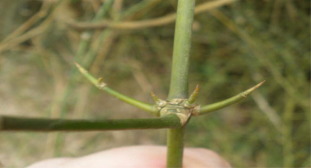
The B. vulgaris is best used for products that do not require long-term durability, such as temporary scaffolding, poles and farm material, since the stem wall is not very strong. Stems can be treated with preservation solution to ensure longer and more durable use. The shoots are edible. B. blumeana is much more durable. Although the thorns make harvesting difficult, this bamboo species can be used for long lasting furniture, fishing poles and handicrafts.
Distribution of wild bamboo on Guam
The distribution of bamboo on Guam appears, from aerial photograph analysis using the Geographic Information System at the Guam Historic Preservation Office, to follow a general set of criteria, including:
- (1)
- Southern Guam (any bamboo in the North is of area less than 0.1 square acres and found in single clumps; this occurrence is rare)
- (2)
- Freshwater sources (mainly rivers)
- (3)
- Disturbed areas
This pattern follows the Guam split of north being of limestone origin and south of volcanic basalt. The first two criteria are linked, as the limestone north does not possess rivers and relies on an aquifer and piping for water needs. For the third criteria – isolated clumps are generally caused by human activity or natural disturbances near river ways and the prolific reproductive and growth habits of bamboo. The only species that can be determined with the imagery is B. vulgaris. The square acreage of non-cultivated bamboo is estimated by aerial photograph analysis (Figs. 6–8).


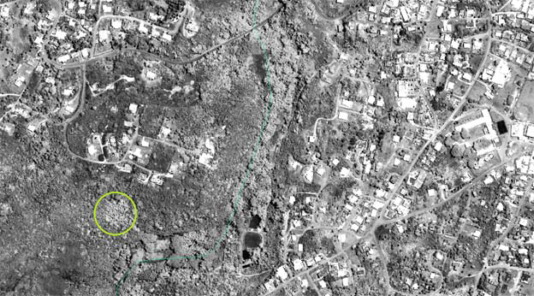
The distribution of bamboo on the island of Guam is discontinuous. B. vulgaris is the most prevalent. It is found mostly along the southern waterways of Guam and estimated in excess of 100 square miles (Fig. 6). Blue lines are rivers, green shapes are bamboo locations identified in Southern Guam. Note the pattern of significant growth (areas in green) along the waterways of lower elevation. There are fewer waterways in northern Guam, and no detectible marked areas of B. vulgaris growth (Fig. 7). In central Guam, small patches are detectable in disturbed areas (Fig. 8). Blue line is a river. Yellow circle shows a bamboo cluster growing in a discontinuous that is not directly along a riverbank. The full acreage is unknown due to the limitations of aerial photograph analysis. A large-scale bamboo industry on Guam would need to be supplemented with cultivated bamboo.
The amazingly versatile bamboo
Important to Asian economies and families
Bamboo has an astounding variety of uses and is an important commodity in Asia. It is an important source of economy, building material and food to rural India (Basumatary et al., 2015; Singh et al., 2003) and Bangladesh (Islam, 2004). In the northern Philippines bamboo is used mostly by families for homebuilding and making farm tools, and commercially for furniture in crafts (Pabuayon, 2004).
The estimated total world bamboo trade was 7 billion US dollars in 2008 (Mayank, 2008), and is expected to grow to 17 billion by the year 2017 with mid-level growth projected. The vast majority of bamboo manufacturing companies are located in Mainland China, with India, and Vietnam producing at a distant second and third. Manufacturing facilities range from 1000 square meters to over 100,000 square meters. Customers order raw bamboo plants, materials, finished consumer products, edible bamboo extracts and other products, often online.
Medicinal bamboo extract
Extracts are used medicinally, and considered to have numerous health benefits including, lowering blood pressure, anti-inflammatory effects, and diuretic effects due to a high content of potassium. The edible shoots and the charcoal are also considered by many Asians to have medicinal properties and health benefits.
Building materials
In China bamboo is used extensively for building (Hsiung, 2015). For building all parts of houses, bamboo is used for the beams, frames, floors, walls, partitions, ceilings, doors and windows. Bamboo is also used to build bridges, ladders, furniture, musical instruments, sports equipment, tool-handles, fishing-net frames, and boating poles. Bamboo plywood can be used for architectural cement form work, floorboards of coaches and railway carriages, container floorboards and bamboo packing boards, wood based panels, laminated flooring and parquets. Bamboo forest chemical by-products include gum rosin and turpentine.
Clothing, home crafts and furniture
Laminated bamboo products include pencils, tables, furniture, handicrafts, cups, and paper plates. Although plastics and timber wood dominate these markets, the largely untapped bamboo market is on the rise. Another product on the rise in the world market is bamboo embedded clothing. Bamboo rayon, a semi-synthetic cellulose fiber alternative to cotton, is increasing in importance due to its natural strength. Bamboo poles are used to make items for home or commercial use, including kitchenware, wall hangings, furniture, floor rugs and mats, chairs, tables, vases, baskets, beds, bed sheets and blinds.
Bamboo charcoal for food, medicine and cooking
Bamboo charcoal is traditionally used as a substitute for wood charcoal or mineral coal. It has excellent properties to serve as a fuel, absorbent and as a thermal conductor and insulator. The calorific (heat) value of bamboo charcoal is almost half that of oil of the same weight. Activated bamboo charcoal is used for cleaning the environment, absorbing excess moisture and producing medicines. The absorption capacity of bamboo charcoal is six times that of wood charcoal of the same weight. It has widespread applications, including for fish tanks, in food, in diapers, to cleanse toxicity in chemical spills, medicines to name just a few.
China is the current leader in its production. At present, Japan, Korea and Taiwan are the main consumers, but importation is rapidly expanding in Europe and North America. Bamboo grows faster and has a shorter rotation compared with tree species. The calorific value and absorption properties of bamboo charcoal are similar to or better than those of wood charcoal. Additionally, bamboo is cheaper and easier to produce than wood products.
Edible bamboo
Of 1575 species of bamboo known worldwide, 110 are edible (Schroder, 2012) and they are a very important food source in Asia. B. vulgaris, has edible shoots used across Asia, but they must be boiled to remove toxicity. Bamboo shoots are typically used in soups to add flavor and texture.
Guam’s bamboo
B. vulgaris, at present the most available and prevalent species in Guam, can best be used for charcoal, temporary building products and grown for edible shoots.
Likely the best potential use for bamboo for the island of Guam is charcoal. Charcoal requires little to no real industrial technique to create, and require no chemicals for production. The only issue with charcoal production with B. vulgaris is the potential air pollution it may cause. Due to the fiesta custom there is a large demand for charcoal use at BBQs on the island. In addition, there are many other uses that might be developed for local use as well as export for bamboo charcoal – including aquarium use, in foods and for water purification.
A second potential use for B. vulgaris and other bamboo varieties that may be have great potential in Guam is for food products. As an island, Guam relies on imported food and food products grown here are sought after. Shoots can be developed in small garden plots and greenhouses, and harvested and processed simply for export and domestic use.
Due to lack of long-term durability, there wouldn’t likely be a great demand for it for permanent building and housing materials. Yet, there is a potential for using bamboo for temporary housing products. Also, temporary housing materials could be exported.
Manufacturing bamboo products in Guam
The first step in opening a manufacturing business on Guam is to determine the location best for the business. Guam Department of Land Management (2014) suggests reviewing options in the southern area of Guam because bamboo is most prevalent in the south and it will save on transportation costs. However, the south is mostly residential and agricultural zoning so there aren’t many possibilities for locating industrial manufacturing plants in the southern region. Zoning and regulations for opening a manufacturing business are available online (United States Environmental Protection Agency, 1986).
Bamboo charcoal: Agricultural zoning isn’t a good fit for the bamboo manufacturing process of making charcoal. This requires burning the bamboo – against the rules for agricultural zoning. The only feasible option at this time for manufacturing bamboo charcoal is to place the business on a commercial zone – likely in northern Guam. That means harvesting bamboo in the south, then transporting up to 30 miles to an industrial site in the north.
For manufacturing licenses in commercial zones, applications and forms must be filled out and approved by various agencies. Applications are available at Guam Department of Revenue and Taxation (Government of Guam, 2015a). Guam’s Fire Department and Department of Land Management requires approval (Guam Department of Land Management, 2014). Food products also require sanitary and health permits. Rules and regulations are viewable online (Guam Division of Environmental Health, 2015). Manufacturing businesses are subject to the laws and regulations of each of these agencies, available online (Supreme Court of Guam, 2014).
Temporary housing material: this product isn’t viable in Guam because it isn’t insurable. However, construction companies may be interested in temporary housing for their workers. Citizens of Guam would not likely purchase the material for housing because insurance companies aren’t willing to insure it.
Bamboo shoots, handicrafts and furniture: these products most likely require the locating of manufacturing business in a light industrial or commercial zone. A residential or agricultural zone in the southern region of Guam might be used as for light commercial purposes upon obtaining approval from residents in the area. Or, available buildings already in place might be utilized in the central or northern region of Guam. Farm to Table Guam Corporation (2015) website provides the steps to opening a food business in Guam: (1) write business plan, (2) set up legal business, LLC or corporation, (3) register “doing business as” names (4) obtain a Federal Employer Identification Number, or EIN (United States Internal Revenue Service, 2015), (5) obtain a business license (Government of Guam, 2015b), (6) obtain a sanitary permit (Guam Division of Environmental Health, 2015) and (7) create and execute a marketing plan.
Impacts on island ecology
According to the Guam Environmental Protection Agency and the Guam Department of Agriculture, no research has been conducted relating to the manufacturing and the processing of bamboo (Guam Department of Agriculture, 2014; Guam Environmental Protection Agency, 2014). This resource, although it has great potential, has not been utilized and marketed industrially on Guam.
If it were, environmental factors concerning soil erosion, deforestation, water pollution, loss of habitat in both land and water, reef damage, and the exposure of harmful chemicals and vapors to employees should be considered.
For a manufacturing business, it is recommended that the business owners take safety measures to protect both the environment and the workers by using cultivation methods to prevent soil erosion and providing manufacturing employees with protective gear. Soil erosion causes deforestation and the loss of habitat in the land and ocean, including the reef. Protecting the reef is important to Guam because it protects the island from natural disasters. Also, it is crucial to keep in mind the importance of keeping the manufacturing employees safe by providing them with protective gear to prevent them from the exposure to harmful chemicals and vapors. By following protective measures for the environment and the people, the bamboo manufacturing business has good potential to prosper and be a part of Guam’s economy.
Skilled workers needed for manufacture
Many factors are involved when opening a business on Guam, such as who is to be involved in the business. Workers are assets that are always needed. There are various types of workers, and the type of business will determine what kind of workers is required. With a manufacturing plant, three types of workers may be needed. These types of workers are skilled workers, unskilled workers, and semi- or mid-skill workers. Skilled workers have specialized skills and are in charge of creating the product (Mahuron, 2014). Mid-skilled workers have some skills, while unskilled labor doesn’t require skills.
For producing charcoal from the most prevalent plant, B. vulgaris, a manufacturing plant would have to be set up. Within a bamboo charcoal manufacturing plant, these three types of labor would be needed. Skilled laborers will be needed to be able to manufacture the bamboo charcoal, to make sure also that it is being made correctly. Semi-skilled laborers will also be needed to help the skilled workers, this type of laborers will most likely act as assistants to the skilled laborers. Unskilled workers will be needed to be on the fields doing much of the farm laboring.
Since there is no current bamboo manufacturing or market in Guam today, there is little chance of skilled workers available. With hiring local not an option, experienced foreign workers must be hired and brought to Guam.
India and China have the largest bamboo resources and market in the world, and skilled and mid-skill workers India and China could be brought in for bamboo manufacture on Guam. To hire foreign workers, documentation is required, as well as housing. Since Guam is a territory of the United States, a working visa will be needed for these workers from India and China to be able to come to Guam to work. Having foreign workers on Guam is not new, there has long been an influx of workers to build the roads, housing and infrastructure of Guam.
A successful bamboo manufacturing plant on Guam requires skilled workers. Without trained professionals, it would be difficult to start a manufacturing plant. This type of business would not be successful if the product is not of high quality.
Perspectives of island young adults
The average participant in the perception survey (Fig. 9) is male and 18–26. Results indicate the current lack of interest in jobs involved in the producing of bamboo in Guam (Fig. 10). Especially, local young adults are not interested in harvesting (89%) jobs that a bamboo market would provide. They are also not interested in making or manufacturing bamboo on Guam (72%). However, there is more interest in selling the products (35%) and even more in paying more for reusable bamboo products (42%).
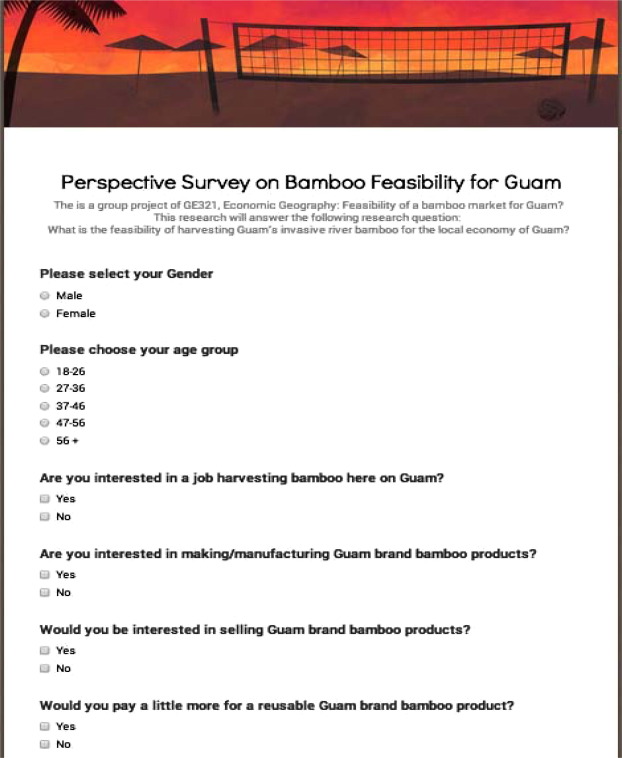

While the lack of interest in harvest and manufacture was initially daunting to the economic geography students, they quickly understood the value of the information. Development of a bamboo industry will best involve locals, especially young locals, in the selling and marketing aspects. Manufacture could be outsourced, or could employ workers brought in from other places. The proximity to Asia and many workers skilled in the bamboo industry is fortunate.
The economic geography class students unanimously agreed that upon learning about bamboo their excitement about the possibilities for bamboo grew. Education regarding bamboo potential, products and uses may certainly alter future survey results. Bamboo charcoal and food products produced here in Guam would be of great value to the local community. Other bamboo products would be highly attractive to tourists and for export. Exposure to the types of bamboo grown on Guam and valuable product alternatives they could offer is needed. Continued work is planned for fall, 2015 for the economic geography class project.
Guam’s market feasibility
The bamboo resource on Guam, so useful in historic CHamoru society, has no current industry or market. The major challenge is the current lack of knowledge of what it could be used for and what could be developed. However, there is also great potential for developing an industry and market that does increase the resiliency of the island’s economy. Domestic market feasibility is good for the making of bamboo charcoal. Local Chamorro food typically includes barbeque, which makes bamboo charcoal more useful for local usage. It could also play a role in how the cooking is done in many of the tourist spots that involves grilling. Paper plates and paper cups may be preferable at fiestas, incorporating bamboo paper products to help keep Guam’s environment cleaner and safer in comparison to using Styrofoam products. This is in keeping with many current island initiatives and desire for increasingly sustainable living, including the University of Guam ban on the usage of Styrofoam.
A bamboo farm once started could continue to exist for years and provide income. However, starting one needs extensive planning and preparation. There are many, many uses for bamboo. The best uses for B. vulgaris are the production of charcoal, shoots and possibly temporary housing material.
Guam’s jobs have increased compared to last year (Daleno, 2014). The emergence of the bamboo products industry can generate more. Ongoing projects such as the Guam Regional Medical City and the Dusit Thani Guam Resort are expected to add hundreds of jobs. A bamboo industry can create many types of jobs from the agricultural, industrial and service sectors. Bamboo cultivation, harvesting, materials processing, care, product development, manufacture, sales, export and transportation of materials can each generate labor for the island. Only the skilled labor required for manufacture would need workers brought in from off island. The tourist industry would benefit greatly from a Guam brand array of bamboo products grown and produced on the island. Branding is hugely important in marketing. Guam brand products are in short supply on the island. Guam bamboo products with the Guam brand would be highly attractive to tourists, who seek Guam products and currently find them scarce.
The Guam Product Seal (GPS) Program stimulates economic opportunities on Guam by promoting the manufacturing of local products (Guam Economic Development Authority, 2014). Plans to either consume or manufacture bamboo enables registration of products under the Guam Product Seal. Consumers are able to distinguish which products are solely “Made on Guam”, and there is a great demand for them among the increasing numbers of Japanese, Russian, Chinese and European tourists. An important benefit of this seal is that the words Guam and Chamorro may appear on the label if the product is a GPS holder.
In Summary:
- (1)
- Guam’s most prevalent bamboo is B. vulgaris, although other varieties will grow well here as well.
- (2)
- Best uses for B. vulgaris are for charcoal, food and temporary housing
- (3)
- There is terrific potential for this industry and market in Guam due to its fiesta (charcoal) and food culture (shoots and charcoal), creation of jobs and creation of Guam brand products
- (4)
- Education is needed in order to generate interest in developing products, domestic and export market.
- (5)
- Bamboo is fast growing and resilient, enabling production and sale of products quickly and sustainably, improving jobs and economy.
Conclusion
The island of Guam, at the crossroads of the Asia Pacific, has a long history of change. Typhoons, earthquakes, centuries of influxes of other people and cultures has engendered a people and island that is versatile and adaptable. Bamboo, an amazingly versatile plant that grows well in Guam, has incredible potential here. The current most widespread species of bamboo, B. vulgaris, can be used for charcoal for domestic use and export, for food and for temporary housing needs.
There are issues with transportation and manufacture. Since the majority of available bamboo is located on southern waterways that are not very assessable, it would be difficult to harvest and transport it to the north, where manufacture and industrial processing would be easiest to accomplish. There are also permitting issues. Burning the bamboo to process it for charcoal couldn’t be done on residentially zoned lands. Local perception, especially among the young adults here – isn’t currently positive. Most interest is shown in the selling and buying of bamboo products. If there were manufacturing plants developed here, there would need to be skilled workers brought in from elsewhere, likely from Asian originations such as China, Korea and Taiwan. While it certainly may be viewed as a negative that the young adults here don’t have an interest in harvesting and manufacturing, it is beneficial to determine the issues so that they may be further explored and addressed.
There is high interest in the possibilities of bamboo as food, and in bamboo charcoal for barbeque due to the important fiesta culture on the island, which is also attractive to visitors and tourists. A bamboo handicraft market could lead to and export economy, as well as improve greatly the important tourist sector, with products that are sustainable and stamped with the Guam brand.
A growing demand with untapped potential is the growing of bamboo shoots for food and medicinal purposes. The marketing of bamboo food products in Asia has great potential and bamboo can be grown easily in Guam in Greenhouses and small garden sites. This would utilize other varieties and could be grown on residentially owned lands. Bamboo shoots grow quickly and are inexpensive to process and develop. Additionally, the thorny B. blumeana, currently cultivated in garden and household plots across Guam, may be utilized for craft business. The business is easy to start us and ecologically friendly, with little negative impacts to the island and inhabitants.
With education of bamboo uses and marketing potential, B. vulgaris for manufacture of charcoal for barbeque briquettes, food, charcoal, aquariums, water purification and many other uses has a great potential for improving the market. The results of this study will be used in further explorative work this fall, 2015 on improving public perception using the social networking methods developed with the assistance of an economic geography class. Perhaps the greatest result of this study was that young adults, while often apathetic and pessimistic about their economic future in today’s economic condition, become excited and motivated when they are involved in marketing development methods and possibilities that work for them. There is great potential for developing an industry and market that improves the resiliency of the island’s economy, bestowed from the superb resiliency bamboo itself. This initial investigation into bamboo’s potential is an opening for an industry that is ecologically friendly and tailored to be culture friendly to the next generation.
It is hoped this work provides information and ideas to develop products and markets for the versatile bamboo here and else with the intention to improve the health of land, people and economy.
Special acknowledgements
The sixteen students of the fall 2014 economic geography class at University of Guam are pioneers in visioning a better future for themselves, their island and generations to come. Listed alphabetically: Bridgette Almario, Zaira Araos, Virgilio Baisa, Annalyn Buan, Nicole Cornelison, Henny Elayda, Pavlina Fojtikova, Ai Gondo, Alvinalynn Gumataotao, Holly Leon Guerrero, Ione Llagas, Ann Marie Morcilla, Alissa Paine, Jonathon Sablan, Raymond Smithwick and Tiara Terlaje.
Special thanks from all of us to Rich Olmo and Bob Barber for Guam specific expertise and kindly offered assistance.
References
- Basumatary et al., 2015 A. Basumatary, S.K. Middha, U. Talambedu, B.K. Brahma, A.K. Goyal Bamboo, as potential sources of food security, economic prosperity and ecological security in North-East India: an overview. Res. Plant Biol., 5 (2) (2015), pp. 17-23
- Daleno, 2014 Daleno, G., 2014. Guam Jobs Increase Moderately. Guam Pacific Daily News. <http://www.guampdn.com/article/20141114/NEWS01/311140012/Guam-jobs-increase-moderately> accessed November 2014.
- Farm to Table Guam Corporation, 2015 Farm to Table Guam Corporation, 2015. 7 Steps to Starting a Food Business on Guam. The Guam Guide. <http://farmtotableguam.org/7-steps-to-starting-a-food-business-on-guam/> accessed May 2015.
- Farrelly, 1984 D. Farrelly The Book of Bamboo. Sierra Book Club, San Francisco (1984)
- Government of Guam, 2015a Government of Guam, 2015. Business Privilege Tax Branch, forms from the Guam Department of Revenue and Taxation govguamdocs. <www.govguamdocs.com/revtax/index_revtax.htm> accessed June 2015.
- Government of Guam, 2015b Government of Guam, 2015. Business License Renewal, GuamTAX. <https://www.guamtax.com> accessed June 2015.
- Guam Department of Agriculture, 2014 Guam Department of Agriculture, 2014. Forestry and Soil Resource Division, Personal Communication, December.
- Guam Department of Land Management, 2014 Guam Department of Land Management, 2014. Personal Communication, December.
- Guam Division of Environmental Health, 2015 Guam Division of Environmental Health, 2015. Rules and Regulations Governing the Issuance of Health Certificates and Rules and Regulations Governing the Issuance of Sanitary Permit. Division of Environmental Health, Department of Public Health and Social Services. <http://dphss.guam.gov/content/division-environmental-health> accessed May 2015.
- Guam Economic Development Authority, 2014 Guam Economic Development Authority, 2014. Invest Guam <http://www.investguam.com/geda-programs/guam-product-seal/> accessed December 2014.
- Guam Environmental Protection Agency, 2014 Guam Environmental Protection Agency, 2014. Air Pollution Control Division, Personal Communication, December.
- Hsiung, 2015 Hsiung, W., 2015. Bamboo in China: New Prospects for an Ancient Resources in Food and Agricultural Organization of the United Nations <http://www.fao.org/docrep/s2850e/s2850e07.htm#TopOfPage> accessed May 2015.
- Islam, 2004 S.S. Islam Stratified two state sampling (self-weighted), for assessment of village forest resources. J. Trop. For. Sci., 16 (1) (2004), pp. 9-16
- Mahuron, 2014 Mahuron, S., 2014. Skilled Labor Vs. Unskilled Labor, Houston Chronicle. <http://smallbusiness.chron.com/skilled-labor-vs-unskilled-labor-46154.html> accessed November 2014.
- Mayank, 2008 Mayank, M., 2008. Techno-Economic Feasibility Study for Setting up Bamboo SMEs. Report from National Mission on Bamboo Applications. Department of Science and Technology, Government of India.
- McClure, 1966 F.A. McClure The Bamboo A Fresh Perspective. Harvard University Press, Cambridge (1966)
- Owen, 2010 A. Owen Guam Culture, Immigration and the US Military Buildup. Asia Pac. Viewpoint, 51 (3) (2010), pp. 304-318
- Owen, 2011 A. Owen Culture change dynamics in the Mariana Islands. Pac. Asia Inq., 2 (2011), pp. 165-194
- Owen, 2012 A. Owen Causes and trends in culture change today: CHamoru and Filipino Societies on the Island of Guam. G.R. Hayes, M.H. Bryant (Eds.), Psychology of Culture, Nova Science Publishers (2012), pp. 47-69. ISBN: 978-1-62257-274-8
- Pabuayon, 2004 I.M. Pabuayon Consumption value and income potential of bamboo in the Philippines: evidence from selected areas and case studies. J. Bamboo Rattan, 3 (3) (2004), pp. 249-263
- Raulerson and Rinehart, 1991 L. Raulerson, A. Rinehart Trees and Shrubs of the Northern Mariana Islands. Commonwealth of the Northern Mariana Islands Coastal Resource Management, Saipan (1991)
- Schroder, 2012 Schroder, S., 2012. Edible Bamboo Species, Guadua Bamboo. <http://www.guaduabamboo.com/types/edible-bamboo-species> accessed June 2015.
- Singh et al., 2003 H.B. Singh, B. Kumar, R.S. Singh Bamboo resources of Manipur, an overview for management and conservation. J. Bamboo Rattan, 2 (1) (2003), pp. 43-55
- Supreme Court of Guam, 2014 Supreme Court of Guam, 2014. Session Laws of the Guam Legislature, Compiler of Laws. <http://www.guamcourts.org/CompilerofLaws/GCA/21gca/21gc060.PDF> (PDF) accessed June 2015.
- Tolentino, 2015 Tolentino, D., 2015. Ancient CHamoru Fishing Tools, in Guampedia. <http://www.guampedia.com/ancient-chamorro-fishing-tools/> accessed May 2015.
- United States Central Intelligence Agency, 2014 United States Central Intelligence Agency, 2014. The World Fact Book. <https://www.cia.gov/library/publications/the-world-factbook/geos/gp.html> accessed May 2015.
- United States Environmental Protection Agency, 1986 United States Environmental Protection Agency, 1986. Revised 2005 Guidebook to Development Requirements on Guam. <http://www.epa.gov/region9/islands/guam-workshop-2011/pdf/BspGuidebook-DevReqs-Guam1.pdf> (PDF) accessed December 2014.
- United States Internal Revenue Service, 2015 United States Internal Revenue Service, 2015. Apply for an Employer Identification Number. <http://www.irs.gov/Businesses/Small-Businesses-&-Self-Employed/Apply-for-an-Employer-Identification-Number-%28EIN%29-Online> accessed May 2015.
- Wikipedia, 2007 Wikipedia, 2007. File Guam-administracja.png, Wikipedia Commons. <https://en.wikipedia.org/wiki/List_of_populated_places_in_Guam> accessed May 2015.
